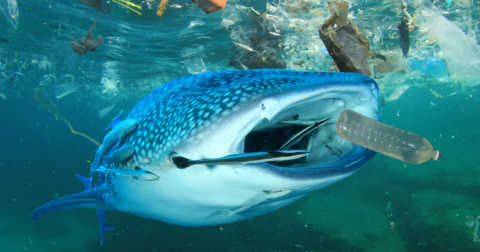Solutions
Eating Just 10% Less Meat Could Help Protect Drinking Water
Climate•6 min read
Explainer
Humans who eat seafood are also eating their own waste.


Words by Grace Hussain
Everyone on the planet, including humans, is affected by ocean pollution. Unfortunately, the ocean has for decades served as a dumping ground where everything from plastics to toxic metals ends up. Our behavior has resulted in contaminated seafood, massive dead zones and compromised biodiversity.
The waste humans create doesn’t stay secluded in the ocean: it ends up back on our plates, where we eat our own waste for dinner. In other words, it harms us too.
Pollution in the ocean is pervasive. Estimates suggest that there are 5.25 trillion individual pieces of plastic in the ocean — a number that is nearly impossible for the human mind to fathom. For some perspective, there are roughly 656 times as much plastic in the ocean as there are people on earth.
When you hear “Pacific Garbage Patch,” you’re probably imagining a large continuous patch of garbage made up of everything from fishing nets to bottles. However, the reality is that much of the plastic found in this area has been broken down into tiny pieces, many of which you’re not able to see.
Plastic isn’t the only type of pollution wreaking havoc on the world’s water. Many coastal areas and bays fall victim to dead zones, which can result from an oversaturation of nutrients in the water.
Certain types of fishing, such as trawling, can cause dead zones. So can agricultural pollution on land. In 2017, the meat giant Tyson was blamed for creating the largest dead zone ever recorded in the Gulf of Mexico. The dead zone covered an area the size of New Jersey.
The areas are called dead zones because there’s so little oxygen in the water that nothing can survive. Toxins from animal waste make their way to the Gulf through rivers, where they create nutrient-dense marine environments. Algae then bloom in very high densities, depriving water of oxygen. The resulting low-oxygen environment forces marine life to leave the area, or else perish.
Nonpoint source pollution, or runoff, originates from various sources — sewers, rain drains and agriculture among them. However, it all ends up in the same place: the ocean. Oftentimes, this runoff brings with it harmful chemicals and other types of waste that can wreak havoc on water quality and can also shut down beaches.
Though banned in the United States, factories in some parts of the world release chemicals directly into the oceans.
You might remember the Deepwater Horizon oil spill, a period of 87 days in which 4 million barrels of oil flowed freely into the ocean from a defunct oil rig. The event was an ecological disaster from which the oceans have still not fully recovered more than a decade later.
Compared to oil rigs and factories, letting napkins be blown off your picnic blanket may not seem like a big deal. But the reality is that if everyone thinks that way, the impacts are detrimental.
In 2020, there were 50 billion pieces of litter along roads and highways in the United States. Much of that litter will make its way into oceans, thanks to runoff from other sources and rain.
Though a relatively new venture, experts caution that deep sea mining will be crippling for ocean ecosystems. Despite these warnings, over two dozen permits for gathering gold from the ocean’s floor have already been issued.
Humans are the drivers of ocean pollution, regardless of whether that pollution comes directly from our factories or factory farms. Our pollution comes in a few different forms: agricultural, chemical, light, noise and plastic.
Agricultural pollution comes from farms, whether they raise crops or animals. One example is fish farming, which often has a direct exchange with the ocean. Fish farming allows parasites, waste, pesticides, fertilizers and antibiotics to flow freely into the open water.
Chemical pollutants can come in many forms. Some of the most common are oil, so-called forever chemicals and toxic metals.
Unlike most other types of ocean pollution, we tend to hear about oil pollution in the wake of large one-off events. Perhaps the most infamous example is the aforementioned Deepwater Horizon oil spill, which started in April 2010 and continues to impact the ocean and its shorelines. However, oil pollution also continuously comes from boats and runoff.
So-called ”forever chemicals” are also a source of pollution, and can be found in everything from food packaging to fabrics. They’ve also been found in numerous different species, including wild-caught fish.
Mercury, cadmium and lead have two things in common: they’re all toxic metals, and they can all be found in the ocean. Though they can all occur naturally, people are making matters worse. In the case of mercury, most of it enters the oceans from industrial runoff, or via coal power plant wastewater.
Cadmium and lead are released from plastics. They don’t always stay in the environment, however. They can reattach to plastic consumed by fish or other wildlife, which can then end up as part of the human food chain.
Light pollution comes from artificial sources like boats, offshore mining platforms and coastal cities. The most well-known example of the impacts of light pollution on marine life involves sea turtles, who are disoriented by artificial light. This becomes a problem for nesting mothers, who are often discouraged from nesting sites if they have too much light. Light pollution also affects hatchlings, who are disoriented and take longer to find the ocean, exposing them to predators.
Turtles are not the only animals affected by light pollution: it also impacts certain species of birds, fish and invertebrates.
Noise pollution in the ocean is a widespread problem, affecting various species of fish, invertebrates and marine mammals. Noise pollution can range from relatively low-yet-constant disruption — to the deafening sounds produced by oil and gas exploration, as well as naval sonar.
Even when relatively low in terms of decibels, noise pollution can cause serious problems for ocean life. For example, cetaceans like whales and dolphins are primarily acoustic animals. As marine traffic increases, cetaceans’ ability to communicate and navigate — particularly over long distances — is severely hampered, causing them stress.
On the other end of the auditory spectrum is noise pollution from the fossil fuel industry. In the search for oil or gas deposits on the seafloor, seismic airguns are used to issue extremely loud blasts. They are among the loudest human-made sounds in the ocean. These blasts can travel for 2,500 miles and are repeated every few seconds,24 hours a day, for days or weeks at a time. Seismic airguns seriously disrupt the lives of many marine animals, including dolphins and whales.
Plastic pollution is one of the most prolific types of pollution in the oceans today. Plastic is virtually everywhere. A quick look at our garbage reveals everything from plastic packaging to plastic cups and plates, to appliances with plastic parts. All of it makes its way into the ocean, where it kills wildlife via entanglement and ingestion.
Surprisingly, most ocean pollution comes from the land. According to the National Oceanic and Atmospheric Administration, a staggering 80 percent of marine pollution originates on land in the form of runoff; pollution is swept into oceans through rivers or rain. Septic tanks, automobiles, farms and ranches account for the most marine pollution.
Plastic pollution alone has achieved such an enormous scale that it is now referred to as a pandemic. A World Wildlife Fund report found that an enormous amount of plastic is making its way into the oceans, as well as other environments. Every year, around 500 billion plastic bags are used, and a dump truckload of plastic is dumped into the ocean every single minute.
It’s not just plastic, either. Everything we dump potentially ends up in the ocean and, if that’s not bad enough, some of it makes its way back into us via our food system. Fish containing toxic metals and microplastics are being served up around the world.
Plastic pollution often collects in ocean gyres, also known as trash vortexes. These trash vortexes exist in many of the world’s great oceans. The Great Pacific Garbage Patch, for example, is said to cover an area 1.6 million square kilometers wide.
Marine species suffer from ocean pollution. They get entangled in plastic packaging, and eat the colorful caps and scraps from our food and beverages.
Pollution, specifically chemical pollution, causes dead zones that use up all the oxygen in the water, creating a deadly environment for plant and animal life.
Humans are not spared from ocean pollution. Not only are beaches shut down in the face of excessive runoff or other water pollution events, but the seafood many people consume is often contaminated with plastics, toxic chemicals and metals.
Seafood is not spared from the impacts of marine pollution. Instead, the animals that people eat are permeated by the pollutants we dump into the ocean. When we eat them, we are literally eating our own waste — be it in the form of plastics, toxic metals or forever chemicals.
There’s nothing quite like standing on a shoreline and looking out at the great expanse of blue that is the ocean. Sadly, instead of protecting it, we’re polluting it. Ocean pollution is a complex, pervasive problem driven by consumer lifestyles. It wreaks havoc on ocean ecosystems the world over. More action is needed if pollution is to be curbed — and the global oceans spared.